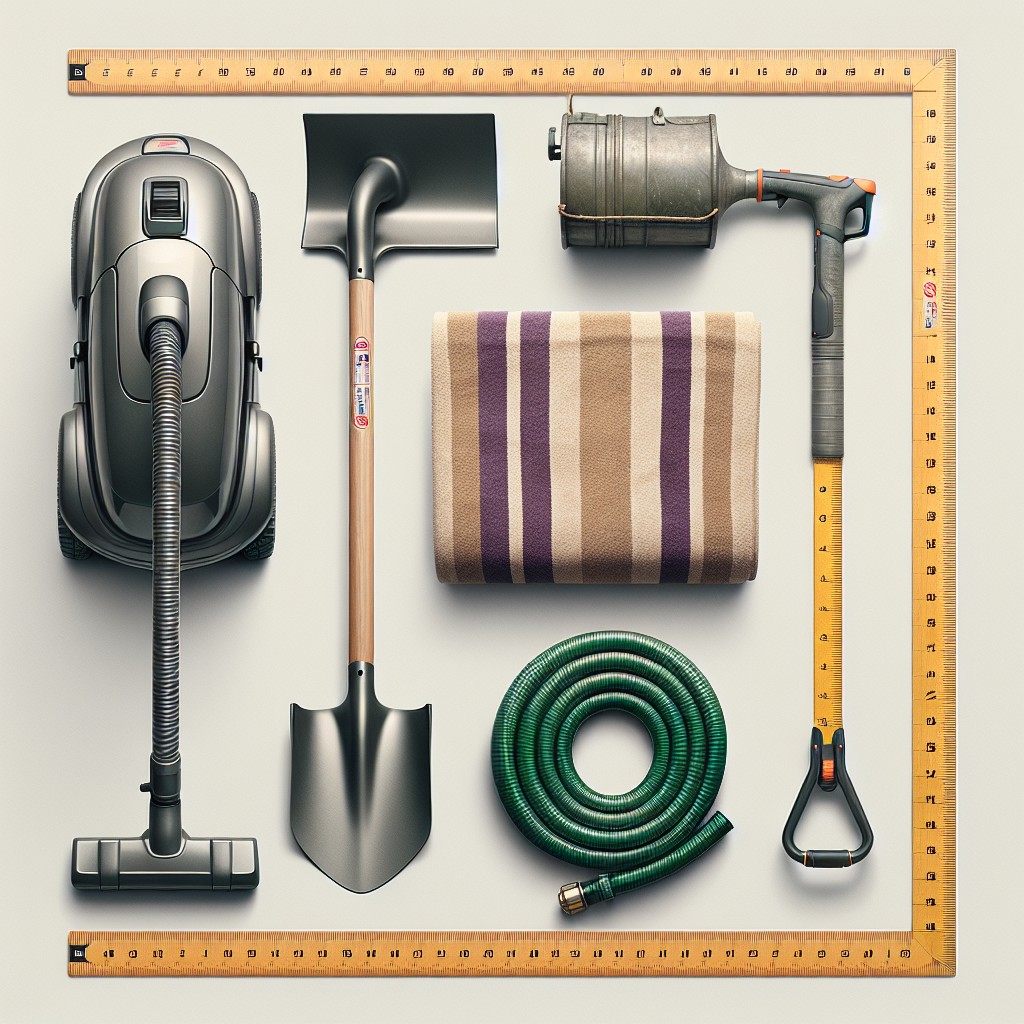Last updated on
Dive right into an explorative journey as we illustrate the scope of 24 inches, comparing its size to daily life objects you can easily relate to.
Key takeaways:
- Kitchen Counters, Baseball Bats, Guitar Necks, Two Subway Footlongs, Yoga Mats
- Furniture, Cabinetry, Interior Design, Children’s Bicycles, Luggage
- Height, Nightstands, Infant Growth, Visualizing Household Items, Sports Equipment
- Outdoor Measurements, Display Technologies, Inch TV Placement, Inch to Centimeter Converter
- 24-inch display size, human height, monitor size, yardstick, and clothing size
What's Inside
Real-world Objects Measuring 24 Inches

To grasp a hands-on understanding of what 24 inches represents in the real world, let’s consider a variety of common objects that embody this measurement:
- Kitchen Counters: Often, standard countertops are around 24 inches deep, which provides ample space for food preparation and appliance storage.
- Baseball Bats: A typical length for a youth baseball bat, it allows a comparison for sports enthusiasts.
- Guitar Necks: Many electric and acoustic guitars feature necks that from the nut to the body measure close to 24 inches, giving musicians a size perspective.
- Two Subway Footlongs: Lined end to end, they epitomize 24 inches and offer a delicious visual for sandwich lovers.
- Yoga Mats: While widths vary, it’s common to find mats that are 24 inches wide, providing a frame of reference for wellness aficionados.
- Luggage: Small to medium suitcases are often 24 inches tall, suited for carry-on requirements and quick mental size checks.
- Toddler Heights: As a point of human scale, many toddlers fall within the 24-inch height range, offering parents an immediate visual benchmark.
Common Uses for 24-Inch Dimensions

In furniture design, a 24-inch height frequently corresponds to standard end tables and stools, optimizing ergonomics for user comfort. In smaller living spaces, a 24-inch width is a sought-after dimension for compact appliances, such as mini-fridges or portable dishwashers, to maximize functional use while conserving space.
In cabinetry, this measurement is pivotal. Kitchen base cabinets might have a standard depth of 24 inches to accommodate standard countertop sizes and maximize storage without encroaching on the workflow area.
For interior design, 24-inch square cushions or wall art dimensions are popular for creating visual interest without overwhelming the space. These items nicely fill in gaps to balance room aesthetics without being overbearing.
Children’s bicycles often have wheels around 24 inches in diameter, a size that provides stability and navigability for young riders.
Furthermore, in the realm of luggage, a suitcase that measures up to 24 inches tall fits within most airline regulations for checked baggage, making it a practical choice for travelers looking to maximize their packing capacity within size constraints.
These examples showcase the versatility of a 24-inch dimension in facilitating everyday comfort, convenience, and functionality.
Comparison of Everyday Items to 24 Inches
To grasp the size of 24 inches, let’s align it with items you encounter daily. First, consider the standard yardstick, which is only 12 inches short of this measure. Now, double the length of that 12-inch ruler you used in school, and you’re there.
Kitchen countertops often stand at roughly 36 inches high, so two-thirds up from the floor is your mark. If you’re an audiophile, visualize two old-school vinyl records end-to-end; each is approximately 12 inches in diameter, combine their lengths and you reach 24 inches.
For the fashion-savvy, the average shoulder width of a size medium men’s shirt is in the ballpark of 18 to 20 inches across, hence stretching a bit further gives a feel for 24 inches. When you eye a subway or deli sandwich claiming to be ‘two-foot-long,’ it’s this exact length they’re boasting about.
Looking at personal technology, the screen on a decently-sized laptop measures diagonally around this length. And finally, think of a standard carry-on suitcase, which abides by airline restrictions, it’s likely to be up to 24 inches tall, making it a perfect model for conceptualizing this measure.
Understanding 24 Inches in the Context of Height
When assessing height, 24 inches is particularly significant for a few reasons. It’s about the height of a two-year-old child, a visual that many parents are familiar with. This size is also relevant for countertop heights, which are typically 36 inches; therefore, 24 inches is two-thirds the standard, giving you a mental yardstick when visualizing kitchen spaces.
In the context of furniture, a nightstand or end table might also match this height, which aligns well with the level of most mattresses, making it a comfortable reach for the average person when lying in bed. Understanding the height of 24 inches can help when selecting appropriate sizes for ergonomic furniture, ensuring that items are neither too tall nor too short for comfortable use.
In personal health, 24 inches is a milestone height for tracking infant growth, offering a tangible benchmark for pediatricians and parents alike. Recognizing objects and landmarks that match this vertical measurement assists in grasping the scale and making more informed decisions, whether in healthcare, interior design, or everyday life.
Visualizing 24 Inches in Household Items
Picture a standard yardstick; it typically measures 36 inches. Now, slice off a third. That chunk you’re left with is pretty close to 24 inches.
Let’s find this measurement around the house:
- Kitchen Counter: The average height from floor to countertop is roughly 36 inches, so two-thirds of that is what you’re looking at for 24 inches.
- The Width of a Dishwasher: Most dishwashers are about 24 inches wide, a snug fit under the counter.
- Guitar: A common guitar has a scale length (from the nut to the bridge) around 24 inches. Rock out with that ruler in mind!
- Two Subway Footlongs: Sandwich lovers, listen up! Lined up end-to-end, two of these can visualize the length we’re discussing.
- A newborn baby: They vary widely, but the length of a newborn can be close to 24 inches, representing a tangible, heartwarming comparison.
These everyday items make it easier to comprehend dimensions that can otherwise seem abstract, bringing a touch of the familiar to our spatial understanding.
Sports Equipment With 24-Inch Dimensions
In the realm of sports, 24-inch dimensions feature prominently, offering a glimpse into the standard sizing for various equipment. For instance, a youth-sized basketball hoop stands at precisely half the official height, making it a perfect practice companion for budding athletes.
Take baseball bats; a typical size for children aged 6 to 7 is a 24-inch length, which aligns with the natural reach and swing mechanics of players in this age group. Gymnastics also utilizes the 24-inch measurement, with the width of a balance beam hovering around this dimension to challenge coordination and precision without compromising safety standards.
In the world of soccer, you’ll find 24 inches marks the width of a regulation size 1 goal, scaled for the smallest players to help them develop their kicking accuracy and game understanding. Even in the accessories sector, gym duffle bags often come in 24-inch lengths, accommodating a full change of clothes and sports gear for athletes on the go.
Understanding these 24-inch applications in sports equipment is crucial, as it underpins the developmental stages of young athletes, ensuring gear is tailored to their size and capabilities. This knowledge assists parents and coaches in selecting the appropriate equipment to foster both the safety and growth of skill in their sporting endeavors.
Inches in Outdoor Measurements
When venturing outdoors, measurements can become tangible and meaningful. Take for example the standard size of a square garden plot, often two feet on each side, providing a clear visual of how 24 inches can define a growing space. It’s the width of a small backyard grill, just right for a family barbecue.
In construction, bricks have a nominal length of 8 inches, meaning three of them end-to-end equates to this measure, a common calculation for masons. For landscapers and gardeners, 24 inches is a benchmark for spacing between shrubs, ensuring each plant has enough room to flourish. Consider stepping stones, which are frequently spaced two feet apart for a comfortable stride.
It’s also the height at which you might find railing on a deck or balcony, designed for safety and to offer a rest for your arms while you take in the view. In essence, when you engage with nature or tackle an outdoor project, this distance is a subtle but essential part of design and functionality.
Display Technologies: 24-Inch Screens
Navigating the world of display technologies, a 24-inch screen represents a sweet spot for many computer users and gamers. For context, imagine lining up four standard rulers end to end or visualizing two Subway footlong sandwiches side by side. That’s the diagonal measurement of a screen we’re talking about—a size that balances ample viewing space with desktop economy.
When deciding if a 24-inch display is right for you, consider desk real estate. It’s large enough to immerse you in work or play, yet moderate enough to fit in most home office setups comfortably. With a widescreen aspect ratio, you can open multiple windows, enhancing productivity or providing a comprehensive gaming experience without overwhelming your field of view.
Resolution is another key factor. Many 24-inch screens come with Full HD (1920 x 1080 pixels), which delivers crisp and clear images without requiring the powerful hardware needed for higher resolutions found in larger screens. It’s an ideal middle ground that makes for a practical choice in both professional and casual settings.
If you delve into the realm of graphic design or video editing, color accuracy and panel technology become pertinent. In this size, you can find screens with IPS (In-Plane Switching) technology, known for its color consistency and wide viewing angles.
Ergonomics shouldn’t be overlooked either. A 24-inch display often comes with adjustable stands that allow for tilting, swiveling, and height adjustments, contributing to a more comfortable and individualized workspace setup.
Last but not least, for entertainment purposes, a 24-inch screen is substantial enough to enjoy films or streaming content, without demanding the space that larger TVs require. It’s an ideal option for those living in smaller spaces or looking for a second screen solution in their home.
Inch TV Placement and Viewing Distance
Selecting the perfect spot for your 24-inch TV enhances the viewing experience. Here are a few points to consider for optimal placement:
1. Sitting Distance: For a 24-inch screen, the ideal viewing distance is between 3 to 4.5 feet. This allows for a full view without straining your eyes.
2. Height Level: Position the TV such that the lower half of the screen is level with your sight line when seated. Typically, this means the center of the screen should be about 40-45 inches off the floor.
3. Angle and Tilt: Minimize glare and reflections by placing the TV away from direct light sources. Some wall mounts offer tilt and swivel options for better angle adjustments.
4. Room Layout: Consider the layout of your furniture. The TV should be easily viewable from different points, ensuring a comfortable watch from your couch, chair, or even the dining space.
5. Cable Management: Ensure the TV location has easy access to power outlets and allows neat cable routing for a tidy setup.
Remember, personal preference trumps all rules. Adjust these guidelines to suit your comfort and room dynamics.
Inch to Centimeter Converter
Switching between inches and centimeters is a breeze with the right tools. A simple formula where one inch equals 2.54 centimeters is all you need.
To convert 24 inches to centimeters, simply multiply by this value, and voilà, you have your centimeters: 24 inches * 2.54 = 60.96 centimeters.
For those who prefer a digital approach, online converters do the math instantaneously – just type in ’24’ and select ‘inches to centimeters’.
Some physical rulers and tape measures come with dual markings, showing both inches and centimeters, making conversions unnecessary and allowing for quick visual comparisons.
This ease of conversion highlights how we can fluidly navigate between the imperial and metric systems in our daily lives.
FAQ
What size is a 24 inch display?
A 24 inch display typically measures about 20 inches wide and 12 inches tall, providing approximately 240 square inches of screen space.
How tall is 24 inches in human height?
In the realm of human height, 24 inches equates to a stature of 2 feet.
Is 24 inch Big Enough?
Yes, a 24-inch monitor is big enough as it provides a broader viewing area, superior image quality, enhanced gaming experience, eye health benefits, saves space, offers versatility, and is quite affordable.
What real-world objects equate to 24 inches in length?
A standard yardstick is 36 inches long, so two-thirds of a yardstick equates to 24 inches in length.
How does a 24-inch diameter impact the capacity of a container?
A 24-inch diameter significantly increases the container’s capacity by providing a larger cross-sectional area which, in turn, boosts the total volume attained.
In clothing sizes, what does a 24-inch measurement signify?
A 24-inch measurement in clothing typically signifies the waist size.




